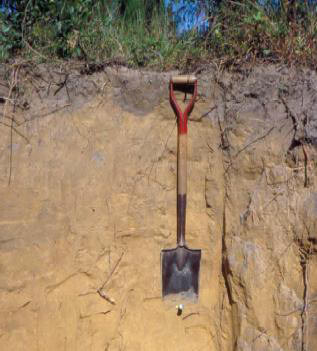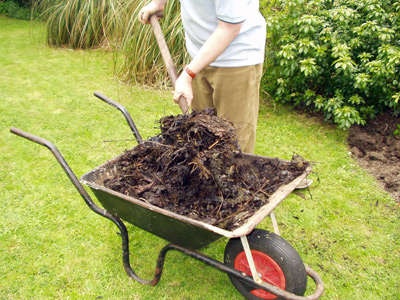 Soil
Improvement - what soil do you have? - how to make it better
Soil
Improvement - what soil do you have? - how to make it better
Many parts of the country, have fairly heavy to very heavy clay soils, in the south chalky soils are common with sandy soils in the east.
Clay soil
On the down side, clay soil is always heavy to work, is slow to warm up in spring, and can be waterlogged. Plants planted into clays generally take longer to establish than on other soils, and growth can be fairly slow at first.
On the up side however, once the plants are established, the soil begins to yield its benefits. Clay soils characteristic of being slow to dry out, of being able to "lift" water from the water table by capillarity mean that plants frequently survive drought periods well even if they are not watered through them. Clay soils are also usually very rich in nutrients. This means that plants that survive the first couple of years on clay tend to grow and survive very well with little intervention.
Chalk soil
Chalk soils are identified not so much by the soil itself as the inclusion of large quantities of pieces of chalk or limestone (calcium carbonate) which makes the soil very alkaline. You probably won't be able to dig down very far in them before you come to a layer of more rocks than soil.
Chalky soils can be light or heavy in the same way as other soils, they can be well drained or have poor drainage (usually they are rather too well drained), be water retentive and nutrient rich or thin and starved of nutrients (starved of nutrients is the norm). Their over-riding characteristic is their alkalinity so you can't grow acid lovers. Organic matter tends to decompose quickly in alkaline soils and so needs replacing regularly, annually or more. Without regular additions of extra organic matter, chalky soils rapidly turn to mud in winter and rock-hard in summer.
Sandy soil
The key feature of sandy soils is that they drain very quickly. Rain just runs through hardly hanging around at all, it doesn't end there because as the rain runs through it it takes dissolved nutrients with it, sandy soils usually have low fertility and are dry. If near the coast they can also be salty which makes them additionally difficult for many plants.
On the positive side sandy soils are relatively light and as it falls apart rather than sticking together even when wet, it is easy to work at almost all of the time, they are very good for root crops and herbs.
What is the Solution? Replace what you have with quality topsoil? A possibility, but consider the logistics. 1 tonne of topsoil delivered will cost from £60 - £90. Unless you are going to use it to raise the height of the garden in some way (raised beds), you will need to remove some existing soil to make room for it. This means that for 1 tonne in, 1 tonne needs to come out. What is coming out is probably going to be difficult to work (otherwise you wouldn't be getting rid of it), and needs to be disposed of - Lots of cost lots of effort.
The Solution;
Stick with what you have got, improve its texture and learn what grows best in it.
| Type | Advantages | Disadvantages | To Improve |
| Clay | Usually very fertile, lots of nutrients. | Poor drainage, heavy to work. Rock hard when dry, horribly sticky when wet. | Add organic matter and maybe gravel. |
| Sandy | Easy to work and easily improved. | Free draining, dries out quickly and relatively infertile. | Add organic matter and use fertilisers. |
| Chalk | Good drainage (usually), while being moisture retentive. Moderate fertility. | Shallow and stony. Forget about Rhododendrons, Camellias and other lime haters except in containers or raised beds. | Add organic matter. |
| Silt | Fairly moisture retentive, workable when wet. | Compacts easily, can be incredibly hard when dry. | Add organic matter |
| Peaty | Loads of organic matter. | Wet and acidic | May need drainage. Add concentrated fertiliser and possibly lime |
| Lovely Loam | Easy to work, good drainage, good fertility, plants love it | Only exists in gardening fairy stories. Keep quiet if you've got this or I'll be round to pinch it. |
Re-cycle garden compost so you're not taking from it and use fertilisers for hungry or very productive plants. |
How do I know which sort of soil I have?
The easiest way is to take some in your fingers wet it thoroughly and rub it between your fingers. Bear in mind though that all soils are mixtures of many different elements and even the most extreme of any types will often have small amounts of the other elements in.
If it "polishes" i.e. makes a shiny smooth coating on your fingers and is greyish brown in colour it's probably clay.
If it's very smooth, but not quite polished and is a dark tan colour, it's probably silt.
If it's very gritty and a pale brownish colour it's probably sandy.
If it's crumbly and dark, but not especially gritty or smooth and shiny, you've got peaty or loamy soil.
As described above, chalky soils can be like many others, the presence of pieces of chalk or limestone defines this soil type.
The main soil improving ingredient is BULK ORGANIC MATTER. If your garden is new then you probably won't have any garden compost around. The chances of scrounging any is negligible, if some one has bothered to make it, then they won't want to give it away.
Organic matter is needed in BULK, not as concentrated chicken manure pellets and the like, though these can add nutrients.
Rather than spend huge amounts of time and energy digging it in (you can do this of course, but I'm assuming that you don't want to), use organic matter when planting and then after as a generous mulch.
Top Tip - spread it on the soil surface between autumn and spring and let the worms take it down for you. This doesn't work with gravel.
Using a good soil conditioner when planting can gain a year or so of growth on plants compared to direct planting into the soil. Get them off to a good start and they'll never look back (it is not a universal panacea, no amount of soil improver will help a plant that is simply in the wrong place). Use the conditioner as a halfway stage between the soft compost of the pot the plants have been grown in, and the harsh reality of your garden soil, and then mulch to 2-3" deep around the newly planted introduction at a radius of 6-12".
Garden compost
What's it like? - Second only to farmyard manure, but not as many nutrients. When properly rotted it won't be at all smelly and shouldn't contain any recognizable plant material bar the odd bit of twig. How to make garden compost.
Where to get it
- Make it yourself - if you have a garden
you should always make your own compost.
- Local Authority Recycling Schemes.
Where I live in Cambridgeshire for instance, all the green
waste collected by the bin men is shredded and composted.
The compost can then be purchased in bags (fairly cheaply)
from local recycling centres or in bulk if you have a trailer
and get it from where it is made when it is free, you just
have to collect it. Such schemes are widespread throughout
the country, try your county recycling website to see what
there is where you live.
- Bulk materials merchants and garden centres.
Well-rotted farmyard or horse manure
What's it like?- The best of all for my money. It conditions the soil and adds nutrients. Make sure it's well rotted, it should smell earthy, not be sticky and and be dark in colour. If it's recently out of the animal it will smell like it, be mid brown or black and probably have recognizable pieces of grass and straw mixed in. Don't use it without composting it for a few months. If it's like this, the poor little plant roots will curl up in disgust.
Where to get it
- Sometimes available in 1 cubic meter bags from suppliers
of topsoil and other bulk materials.
- Garden centres.
- Local equestrian centres or farms, use Google or look in the small ads of the free papers.
If you live in or near the countryside, you may see bags for sale or even given away (I know of a riding school that has to bag it and take it to the local skip - criminal!). These sources may be of fresh manure, be sure to let it rot down before using it. I used to get my supplies from a local farmer who delivered a trailer load locally of about 2 tonnes for very little money until he ran out.
Peat and Old Grow Bags
What's it like?- Generally very clean and pleasant to handle. Compressed bales of around 100 litres are best value (you may need help in handling them). Very good as soil structure conditioners but few nutrients. Use bonemeal or blood fish and bone at the same time to act as a slow release fertilizer. Not very environmentally friendly though and will probably be unavailable before long.
Where to get it
- Garden centres / DIY stores etc. last year's grow bags, or even new ones.
Pea shingle
What's it like? - Pea shingle is sometimes called 10mm stone, it's fairly fine gravel. It is sometimes suggested that you can add sand to poorly drained soil, but this can actually make it worse, as the very small grains can block existing drainage channels, pea shingle is the better option.
Where to get it
- Builders merchants and plant hire companies. In bulk
0.5 - 1 tonne is the cheapest way. Also available
in 25 kg bags from DIY stores.
- Don't get it from the garden centre - very expensive.
Others
Spent mushroom compost, composted bark, spent hops from breweries, seaweed etc.
Depending on where you live, these or others may be available cheaply or for free. The main criteria is always that the conditioner should be crumbly, not smelly and with no or few recognizable raw materials. If you get it in the raw state, then compost it down first as any other organic matter before using on the garden.
Take care though when using any of these, don't use them initially as freely as you might the tried and trusted conditioners. Mushroom compost for instance often has very high levels of lime, so your acid lovers will hate it. Try a small amount in a restricted area first before you order in a truck full. As a rule of thumb assume that they may not be as well rotted as they need to be and store them for a few months if possible before use.
The key thing about bulk organic material is the word BULK, use lots of it! An average soil in a garden of medium size can swallow a tonne or two without any difficulty, so don't worry too much about over-ordering use lots of it!

